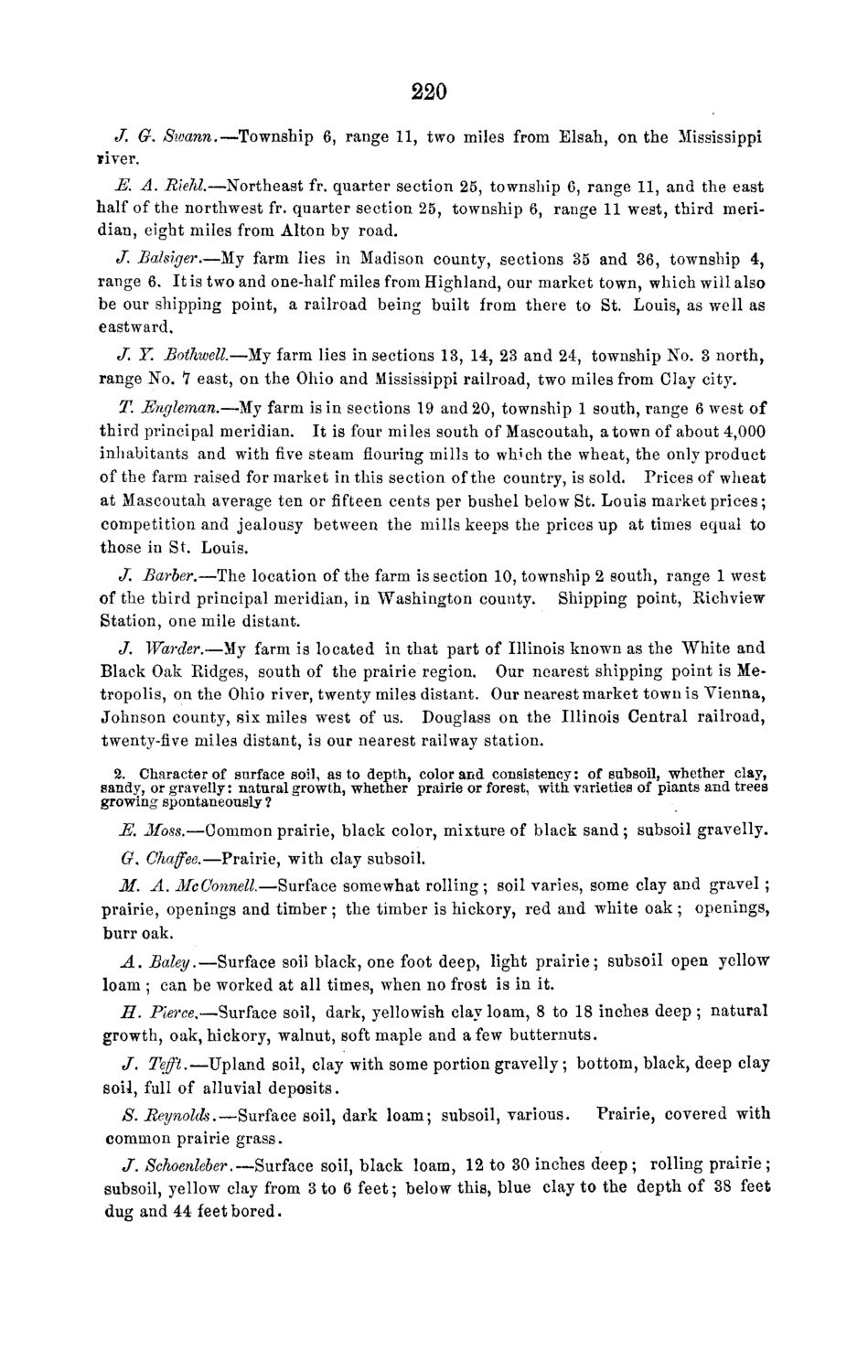| |
| |
Caption: Board of Trustees Minutes - 1868
This is a reduced-resolution page image for fast online browsing.

EXTRACTED TEXT FROM PAGE:
220 J. G. Sioann.—Township liver. 6, range 11, two miles from Elsah, on t h e Mississippi M A. Riehl.—Northeast fr. q u a r t e r section 25, township 6, range 11, and the east half of the northwest fr. q u a r t e r section 25, township 6, range 11 west, t h i r d meridian, eight miles from Alton by road. J. Bahiger.—My farm lies in Madison county, sections 35 and 36, township 4, range 6. I t is two and one-half miles from Highland, our market town, which will also be our shipping point, a railroad being built from t h e r e to St. Louis, as well as eastward, J. Y. Bothwell—My farm lies in sections 13, 14, 23 and 24, township No. 3 n o r t h , range No. * east, on the Ohio and Mississippi railroad, two miles from Clay city. 7 T. Engleman.—My farm is in sections 19 and 20, township 1 south, range 6 west of t h i r d principal meridian. I t is four miles south of Mascoutah, a town of about 4,000 i n h a b i t a n t s and with five steam flouring mills to which the wheat, the only p r o d u c t of the farm raised for m a r k e t in this section of the country, is sold. P r i c e s of wheat at Mascoutah average t e n or fifteen cents per bushel below St. L o u i s market p r i c e s ; competition and jealousy between the mills keeps the prices up at times equal to those in St. Louis. J. Barber.—The location of the farm is section 10, township 2 south, range 1 west of the t h i r d principal meridian, in W a s h i n g t o n county. Shipping point, Richview Station, one mile distant. J. Warder.—My farm is l o c a t e d in t h a t part of Illinois known as the W h i t e and Black Oak Ridges, south of the prairie region. Our nearest shipping point is Metropolis, on the Ohio river, twenty miles distant. Our nearest m a r k e t town is V i e n n a , J o h n s o n county, six miles west of us. Douglass on the Illinois C e n t r a l railroad, twenty-five miles distant, is our nearest railway s t a t i o n . 2. Character of surface soil, as to depth, color and consistency: of subsoil, whether clay, sandy, or gravelly: natural growth, whether prairie or forest, with varieties of plants and trees growing spontaneously ? M Moss.—Common G. Chaffee.—Prairie, prairie, b l a c k color, m i x t u r e of black sand ; subsoil g r a v e l l y . w i t h clay subsoil. somewhat r o l l i n g ; soil varies, some clay and gravel ; M. A. McGonnell.—Surface b u r r oak. prairie, openings and timber ; the timber is hickory, red and white oak ; openings, A. Baley.—Surface soil black, one foot deep, light p r a i r i e ; subsoil open yellow loam ; can be worked at all times, when no frost is in it. H. Pierce.—Surface soil, dark, yellowish clay loam, 8 to 18 inches deep ; n a t u r a l growth, oak, hickory, walnut, soft maple and a few b u t t e r n u t s . J. Tefft.—Upland S. Reynolds.—Surface common prairie g r a s s . J. Schoe?deber.— Surface soil, b l a c k loam, 12 to 30 inches deep ; rolling prairie ; subsoil, yellow clay from 3 to 6 f e e t ; below this, blue clay t o the d e p t h of 38 feet dug and 44 feet b o r e d . soil, clay with some portion gravelly ; b o t t o m , black, deep clay soil, dark l o a m ; subsoil, various. Prairie, covered with soil, full of alluvial d e p o s i t s .
| |